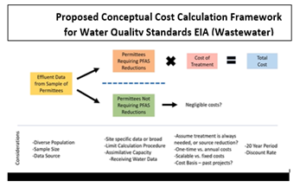Stakeholder Group for PFAS Rules
On Friday, October 9, the Department of Natural Resources held another Stakeholder Group for PFAS Rules. The meeting focused on the background regarding the economic impact analysis (EIA), the EIA conceptual framework for Water Quality Standards rule and wastewater and drinking water sampling efforts.
From a high-level perspective, the DNR Assistant Deputy Secretary Todd Ambs stated the agency has a “three-stool” approach to water quality including nitrate rulemaking, lead pipe removals and PFAS mitigation. Ambs stated that the state will “hold people responsible” for PFAS contamination and require appropriate clean-up action. He also said, “sound science and data” will drive the agency’s decisions and pressed for the need of large-scale sampling to estimate costs.
Here are other highlights from the meeting:
Surface Water Quality Standards (NR 105, 106, 219) and Wastewater Sampling
- DNR plans to develop numeric surface water standards for PFAS.
- The criteria could be one number for all bodies of the state or different numbers for different water types.
- DNR has now moved into developing the EIA and plan to survey a range of direct dischargers permittees throughout the state to develop a data set on PFAS in wastewater effluent.
- DNR plans to do the sampling and analysis.
- DNR believes the collection of the discharges will inform the EIA and future implementation plans.
- The list of proposed facilities for sampling is still under development.
- The data will be made public during the EIA process.
- DNR described their conceptual cost model (pictured here) which will use the effluent data from the sample of permittees as a benchmark to estimate the cost of treatment.

- In addition to the effluent sample data, DNR is seeking several other data elements including costs of source and costs of treatment. DNR also intends to interview consultants and labs.
- DNR is also soliciting feedback on benefits for surface water standards.
Drinking Water (NR 809) and Sampling Efforts
- DNR stated there is a lack of data on PFAS contamination in drinking water systems.
- Other Region 5 states (Michigan, Ohio, Illinois, and Minnesota) have either started or finished sampling efforts.
- DNR plans to start with a targeted sampling pool and will focus on municipal systems near potential contamination sources (this is around 50 systems).
- The costs for the sampling will be covered by the state.
Groundwater Quality Rule (NR 140)
- Cycle 10 rulemaking in process for 26 substances (including PFOA and PFOS)
- Cycle 11 will include 40 substances (including 34 PFAS and 6 pesticides).
- The Department of Health Services (DHS) is currently working on recommendations for Cycle 11, which are expected Oct.- Dec. 2020.
Outlined Timeline for NR 809 and NR 140:
- January 2021: proposed rule language for Natural Resources Board’s review; DNR complete EIA
- February 2021: solicit EIA comments
- August 2021: public hearing and solicitation of comments on rule
Wisconsin PFAS Action Council (WisPac) Seeking Feedback on Draft Plan
In accordance with Executive Order 40, issued by Gov. Tony Evers in August 2019, Wisconsin state agencies have convened the Wisconsin PFAS Action Council (WisPAC). The executive order directs the council to develop an action plan due to the governor and legislature by November 1, 2020. WisPAC has convened two sub-advisory groups: local government group and citizens group.
After meeting through 2019 and 2020, WisPAC released a draft plan. The plan includes recommendations for the governor and legislature’s consideration. Notable recommendations include:
- Establish Science-Based Environmental Standards for PFAS (in progress)
- Test Public Water Systems for PFAS
- Identify PFAS Sources and Reduce Discharges to Wastewater Facilities
- Monitor Background Levels of PFAS in the Environment
- Provide Financial Tools for Local Governments
- Improve Efficiency in Development of Long-Term Water Supply Solutions
Written comments can be submitted on the draft plan until October 31, 2020. DNR held a public listening session on the plan on Oct. 21, 2020.
NRB Vote Scheduled for Fire fighting Foam Emergency Rule
On Wednesday, Oct. 28, the Natural Resources Board will vote on the adoption of Emergency Board Order WA-06-20(E), proposed rules creating chapter NR 159 related to regulating fire fighting foam that contains certain contaminants.
This comes after the NRB pulled back on advancing the emergency rule in their August meeting due to concerns raised by the Water Quality Coalition. Since August, DNR met with numerous stakeholders to collect feedback and revise the emergency rule.
This emergency rulemaking is a result of 2019 Wisconsin Act 101, legislation that regulates firefighting foam that contains PFAS. Act 101 went into effect on September 1st. The Act gave DNR the authority to promulgate rules to implement and administer the act. It also required the DNR to promulgate emergency rules no later than September 1, 2020, to coincide with the bill’s implementation date.